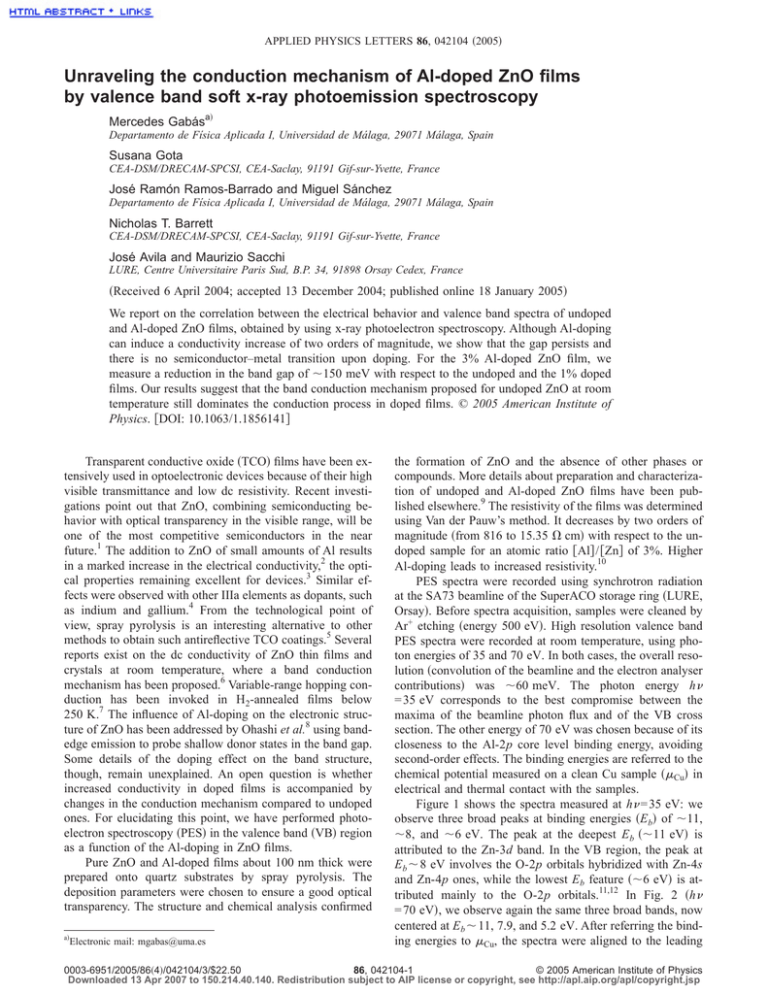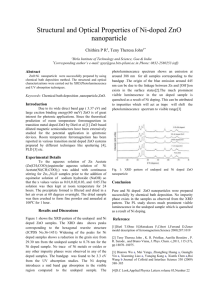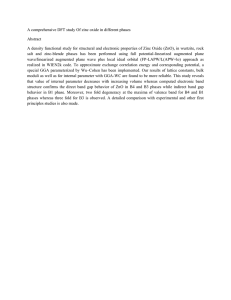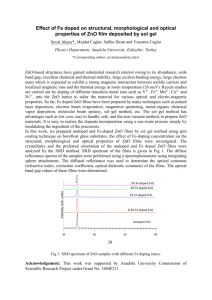Unraveling the conduction mechanism of Al
advertisement

APPLIED PHYSICS LETTERS 86, 042104 共2005兲 Unraveling the conduction mechanism of Al-doped ZnO films by valence band soft x-ray photoemission spectroscopy Mercedes Gabása兲 Departamento de Física Aplicada I, Universidad de Málaga, 29071 Málaga, Spain Susana Gota CEA-DSM/DRECAM-SPCSI, CEA-Saclay, 91191 Gif-sur-Yvette, France José Ramón Ramos-Barrado and Miguel Sánchez Departamento de Física Aplicada I, Universidad de Málaga, 29071 Málaga, Spain Nicholas T. Barrett CEA-DSM/DRECAM-SPCSI, CEA-Saclay, 91191 Gif-sur-Yvette, France José Avila and Maurizio Sacchi LURE, Centre Universitaire Paris Sud, B.P. 34, 91898 Orsay Cedex, France 共Received 6 April 2004; accepted 13 December 2004; published online 18 January 2005兲 We report on the correlation between the electrical behavior and valence band spectra of undoped and Al-doped ZnO films, obtained by using x-ray photoelectron spectroscopy. Although Al-doping can induce a conductivity increase of two orders of magnitude, we show that the gap persists and there is no semiconductor–metal transition upon doping. For the 3% Al-doped ZnO film, we measure a reduction in the band gap of ⬃150 meV with respect to the undoped and the 1% doped films. Our results suggest that the band conduction mechanism proposed for undoped ZnO at room temperature still dominates the conduction process in doped films. © 2005 American Institute of Physics. 关DOI: 10.1063/1.1856141兴 Transparent conductive oxide 共TCO兲 films have been extensively used in optoelectronic devices because of their high visible transmittance and low dc resistivity. Recent investigations point out that ZnO, combining semiconducting behavior with optical transparency in the visible range, will be one of the most competitive semiconductors in the near future.1 The addition to ZnO of small amounts of Al results in a marked increase in the electrical conductivity,2 the optical properties remaining excellent for devices.3 Similar effects were observed with other IIIa elements as dopants, such as indium and gallium.4 From the technological point of view, spray pyrolysis is an interesting alternative to other methods to obtain such antireflective TCO coatings.5 Several reports exist on the dc conductivity of ZnO thin films and crystals at room temperature, where a band conduction mechanism has been proposed.6 Variable-range hopping conduction has been invoked in H2-annealed films below 250 K.7 The influence of Al-doping on the electronic structure of ZnO has been addressed by Ohashi et al.8 using bandedge emission to probe shallow donor states in the band gap. Some details of the doping effect on the band structure, though, remain unexplained. An open question is whether increased conductivity in doped films is accompanied by changes in the conduction mechanism compared to undoped ones. For elucidating this point, we have performed photoelectron spectroscopy 共PES兲 in the valence band 共VB兲 region as a function of the Al-doping in ZnO films. Pure ZnO and Al-doped films about 100 nm thick were prepared onto quartz substrates by spray pyrolysis. The deposition parameters were chosen to ensure a good optical transparency. The structure and chemical analysis confirmed a兲 Electronic mail: mgabas@uma.es the formation of ZnO and the absence of other phases or compounds. More details about preparation and characterization of undoped and Al-doped ZnO films have been published elsewhere.9 The resistivity of the films was determined using Van der Pauw’s method. It decreases by two orders of magnitude 共from 816 to 15.35 ⍀ cm兲 with respect to the undoped sample for an atomic ratio 关Al兴 / 关Zn兴 of 3%. Higher Al-doping leads to increased resistivity.10 PES spectra were recorded using synchrotron radiation at the SA73 beamline of the SuperACO storage ring 共LURE, Orsay兲. Before spectra acquisition, samples were cleaned by Ar+ etching 共energy 500 eV兲. High resolution valence band PES spectra were recorded at room temperature, using photon energies of 35 and 70 eV. In both cases, the overall resolution 共convolution of the beamline and the electron analyser contributions兲 was ⬃60 meV. The photon energy h = 35 eV corresponds to the best compromise between the maxima of the beamline photon flux and of the VB cross section. The other energy of 70 eV was chosen because of its closeness to the Al-2p core level binding energy, avoiding second-order effects. The binding energies are referred to the chemical potential measured on a clean Cu sample 共Cu兲 in electrical and thermal contact with the samples. Figure 1 shows the spectra measured at h = 35 eV: we observe three broad peaks at binding energies 共Eb兲 of ⬃11, ⬃8, and ⬃6 eV. The peak at the deepest Eb 共⬃11 eV兲 is attributed to the Zn-3d band. In the VB region, the peak at Eb ⬃ 8 eV involves the O-2p orbitals hybridized with Zn-4s and Zn-4p ones, while the lowest Eb feature 共⬃6 eV兲 is attributed mainly to the O-2p orbitals.11,12 In Fig. 2 共h = 70 eV兲, we observe again the same three broad bands, now centered at Eb ⬃ 11, 7.9, and 5.2 eV. After referring the binding energies to Cu, the spectra were aligned to the leading 0003-6951/2005/86共4兲/042104/3/$22.50 86, 042104-1 © 2005 American Institute of Physics Downloaded 13 Apr 2007 to 150.214.40.140. Redistribution subject to AIP license or copyright, see http://apl.aip.org/apl/copyright.jsp 042104-2 Gabás et al. FIG. 1. PES spectra of the VB region recorded with a photon energy of h = 35 eV for the undoped ZnO and 1% and 3% Al doped samples. The chemical potential 共兲 measured in a clean Cu sample in electrical contact with the samples is plotted together. Inset: zoom of the low Eb part of the VB region. edge of the Zn-3d peak. The spectra intensity was interpolated by fitting the background at binding energies well above 共⬍2 eV兲 and below 共⬎14 eV兲 the VB. The results presented in Figs. 1 and 2 are fully reproducible using a second series of samples. For a given photon energy, we observe that the overall spectra are almost independent of doping. These data match the VB PES results previously published for undoped single crystals11–13 and powdered14 ZnO. In addition, our results provide a comparison between the VB PES spectra of undoped and Al-doped ZnO thin films. An important result is the evidence that none of the samples 共undoped ZnO, and 1% and 3% doped films兲 presents any density of states in the forbidden band gap region for both series of spectra 共h = 35 eV and h = 70 eV兲. Appl. Phys. Lett. 86, 042104 共2005兲 The small differences between the spectra with doping are localized at the uppermost edge of the PES VB spectra. The insets of Figs. 1 and 2 are an enlargement of this region. In the case of the 3% Al doped sample, we measure a shift of ⬃150 meV of the uppermost edge of the VB to lower binding energies with respect to the other samples 共1% Al-doped and undoped ZnO兲. The same result is obtained at h = 35 and 70 eV, supporting its reliability. We interpret this shift as a narrowing of the band gap. It is known 共see, e.g., Ref. 8, and references therein兲 that the hybridization between states of the ZnO matrix and of the Al dopant yields new donor electronic states located just below the lowermost edge of the conduction band 共CB兲. As a consequence, the chemical potential of the 3% Al-doped ZnO films shifts ⬃150 meV upwards, approaching the bottom of the CB. This fact can be pictured as a narrowing of the effective band gap, and gives rise to an increase of the conductivity. Conclusions about the occupation of the conduction band as a function of doping cannot be drawn directly from our PES experiments. Recently, Imai et al. have published electronic band calculations of Ga-doped and undoped ZnO and ZnS, using density functional theory.15 Previous experimental reports indicate that similar effects are observed upon Al and Ga doping.16 Assuming Ga in a substitutional unrelaxed site, Imai et al. obtain a similar density of states for undoped and Ga-doped ZnO. They also find that the chemical potential of undoped ZnO 共ZnO兲 is well below the bottom of the CB. Our PES data agree with the former result, but are at variance with the latter. In both sets of PES spectra 共h = 35 eV and h = 70 eV兲, we observe a separation of ⬃3 eV between the edge of the VB and Cu. Therefore, the chemical potential of both the undoped and the Al-doped ZnO films is located very close to the lowermost conduction band edge, assuming that the gap of undoped ZnO is 3.4 eV. This position of the chemical potential is consistent with an n-type semiconductor. Although Imai et al. also obtain a displacement of in the case of doped ZnO toward the conduction band edge, the shift does not agree quantitatively with our experimental results. They suggest that shifts into the CB, i.e., the electrons from the dopant Ga atoms occupy the CB, resulting in metallic behavior of the Ga-doped ZnO. Our experimental results, for Al doping, disagree with this finding. The energy distance between the uppermost edge of the VB and Cu is about 3.05 and 2.9 eV for the undoped and the 3% doped sample, respectively.17 This means that the chemical potential of the 3% Al-doped sample shifts toward the lowermost CB edge by ⬃150 meV with respect to the other samples, but the semiconductor character remains in spite of the doping. This shift of ⬃150 meV is very small but measurable, thanks to the good energy resolution obtained by combining synchrotron radiation and a high performance electron analyzer. The consequence of the experimental results presented in this letter is that the band conduction mechanism generally admitted for ZnO6 should also be dominant for the conduction process in doped films. Therefore, a semiconductor– metal transition accompanying the conductivity jump should be excluded. A slight decrease of the optical band gap 共⬃90 meV兲 has also been observed in transmittance measurements when comparing undoped and 3% Al-doped ZnO FIG. 2. PES spectra of the VB region recorded with a photon energy of h = 70 eV for the 1% and 3% Al doped samples. The chemical potential 共兲 measured in a clean Cu sample in electrical contact with the samples is plotted together. Inset: zoom of the low Eb part of the VB region. Downloaded 13 Apr 2007 to 150.214.40.140. Redistribution subject to AIP license or copyright, see http://apl.aip.org/apl/copyright.jsp 042104-3 Appl. Phys. Lett. 86, 042104 共2005兲 Gabás et al. films prepared by spray pyrolysis.10 The absorption edge shifts toward higher values as the aluminum concentration increases up to a ratio of 关Al兴 / 关Zn兴 = 3%, the ratio at which the resistivity minimum occurs. For higher values, absorption edges overlap. These results compare well, qualitatively and quantitatively, with our above-reported findings. Results similar to what we found in ZnO upon doping are observed in Fe3O4 across the Verwey transition.18 Magnetite exhibits a first-order phase transition at TV ⬵ 120 K, with the dc conductivity abruptly increasing by two orders of magnitude when heating through TV. PES spectra taken above 共130 K兲 and below 共110 K兲 TV are identical, except in the region very near the valence band threshold. Neither spectra show a Fermi step. The only detectable change between them is that the high temperature spectrum is shifted by ⬃50 meV to lower binding energy. The band gap does not collapse, but is merely reduced by ⬃50 meV, with no sign of a real insulator–metal transition. Although the parameter controlling the transition in magnetite is the temperature, the persistence of the gap and its reduction are very similar to the results we found for ZnO upon doping. The Fe3O4 and ZnO band gap behavior across the conductivity transition is quantitatively similar, with a shift of several tens of millielectron volts. In summary, the hybridization between the orbitals of the Al dopant and of the ZnO matrix should lead to the appearance of electronic states located just below the lowermost edge of the conduction band. This is reflected in the upwards shift of the chemical potential, i.e., in the narrowing of the effective band gap. No semiconductor–metal transition accompanied the conductivity jump in our 3% Al-doped films. As a consequence, the band conduction mechanism should also be the principal contribution to the conduction process in doped films, as is the case in the undoped ZnO. This work was funded by the Acción Integrada HF20010145 D.G.I. and by MAT2000-1505 MCyT 共Spain兲, and by the Programme d’Actions Intégrées PICASSO n. 04344SH, Ministère des Affaires étrangères et Ministère de la Recherche 共France兲. The authors are grateful to the S.C.A.I. of Málaga University and V. Pérez-Dieste for their technical collaboration. T. Minami, MRS Bull. 25, 38 共2000兲. S. B. Majumder, M. Jain, P. S. Dobal, R. S. Katiyar, Mater. Sci. Eng., B 103, 16 共2003兲. 3 T. Makino, K. Tamura, C. H. Chia, Y. Segawa, M. Kawasaki, A. Ohtomo, and H. Koinuma, Phys. Rev. B 65, 121201 共2002兲. 4 K. Haga, P. S. Wijesena, and H. Watanabe, Appl. Surf. Sci. 169–170, 504 共2001兲; P. Nunes, E. Fortunato, P. Tonello, F. Braz Fernández, P. Vilarinho, and R. Martins, Vacuum 64, 281 共2002兲. 5 J.-H. Lee and B.-O. Park, Mater. Sci. Eng., B 106, 242 共2004兲. 6 J. Shoenes, K. Kanazawa, and E. Kay, J. Appl. Phys. 48, 2537 共1977兲; S. B. Krupanidhi and M. Sayer, ibid. 56, 3308 共1984兲; Y. Natsume, H. Sakata, T. Hirayama, and H. Yanagida, ibid. 72, 4203 共1992兲. 7 Y. Natsume and H. Sakata, Mater. Chem. Phys. 78, 170 共2002兲. 8 N. Ohashi, T. Sekiguchi, K. Aoyama, T. Ohgaki, Y. Terada, I. Sakaguchi, T. Tsurumi, and H. Haneda, J. Appl. Phys. 91, 3658 共2002兲. 9 R. Ayouchi, F. Martín, D. Leinen, and J. R. Ramos-Barrado, J. Cryst. Growth 247, 497 共2003兲; R. Ayouchi, D. Leinen, F. Martín, M. Gabás, E. Dalchiele, and J. R. Ramos-Barrado, Thin Solid Films 426, 68 共2003兲; R. Ayouchi, doctoral thesis, University of Málaga, 2005. 10 H. Mondragón-Suárez, A. Maldonado, M. De la L. Olvera, A. Reyes, R. Castanedo-Pérez, G. Torres-Delgado, and R. A. Somoza, Appl. Surf. Sci. 193, 52 共2002兲. 11 W. Ranke, Solid State Commun. 19, 685 共1976兲. 12 E. I. Solomon, P. M. Jones, and J. A. May, Chem. Rev. 共Washington, D.C.兲 93, 2623 共1993兲. 13 G. Zwicker and K. Jacobi, Solid State Commun. 54, 701 共1985兲. 14 E. P. Mikheeva, S. V. Koscheev, S. Ph. Ruzankin, G. M. Zhidomirov, S. A. Leontiev, V. G. Devjatov, and A. E. Cherkashin, J. Electron Spectrosc. Relat. Phenom. 94, 59 共1998兲. 15 Y. Imai, A. Watanabe, and I. Shimono, J. Mater. Sci.: Mater. Electron. 14, 149 共2003兲. 16 A. Tiburcio-Silver, A. Sánchez-Juárez, and A. Avila-García, Sol. Energy Mater. Sol. Cells 55, 3 共1998兲; K. T. Ramakrishna Reddy, H. Gopalaswamy, P. J. Reddy, and R. W. Miles, J. Cryst. Growth 210, 516 共2000兲. 17 In a recent paper, a value of 3.0– 3.2 eV was obtained from UPS measurements on a ZnO 共1 0 1̄ 0兲 single crystal: K. Ozawa and K. Edamoto, Surf. Sci. 547, 257 共2003兲. 18 J. H. Park, L. H. Tjeng, J. W. Allen, P. Metcalf, and C. T. Chen, Phys. Rev. B 55, 12813 共1997兲. 1 2 Downloaded 13 Apr 2007 to 150.214.40.140. Redistribution subject to AIP license or copyright, see http://apl.aip.org/apl/copyright.jsp



